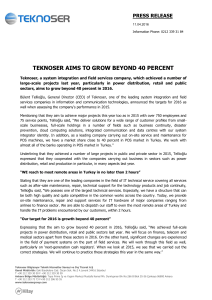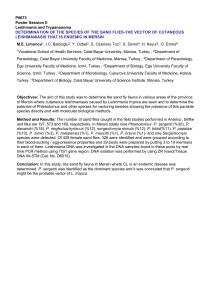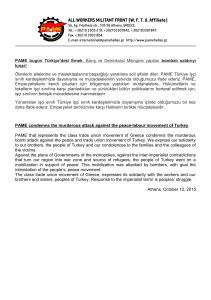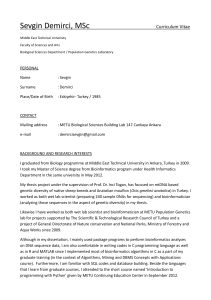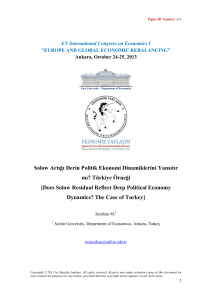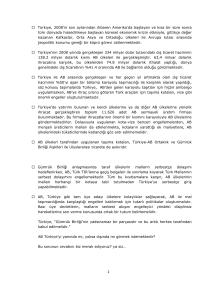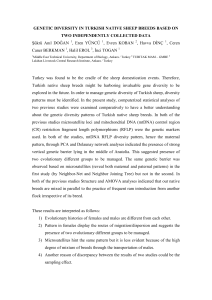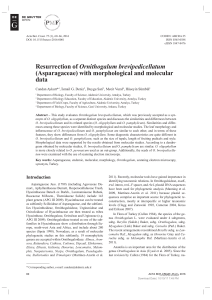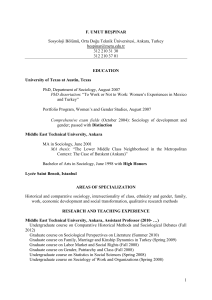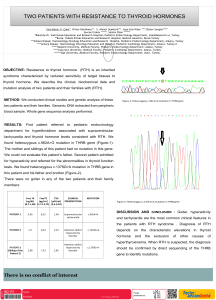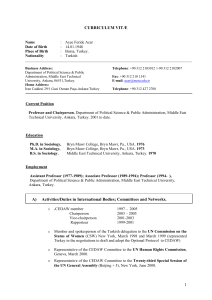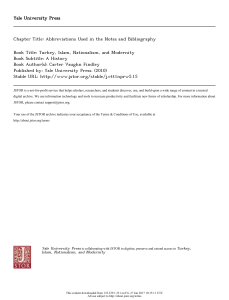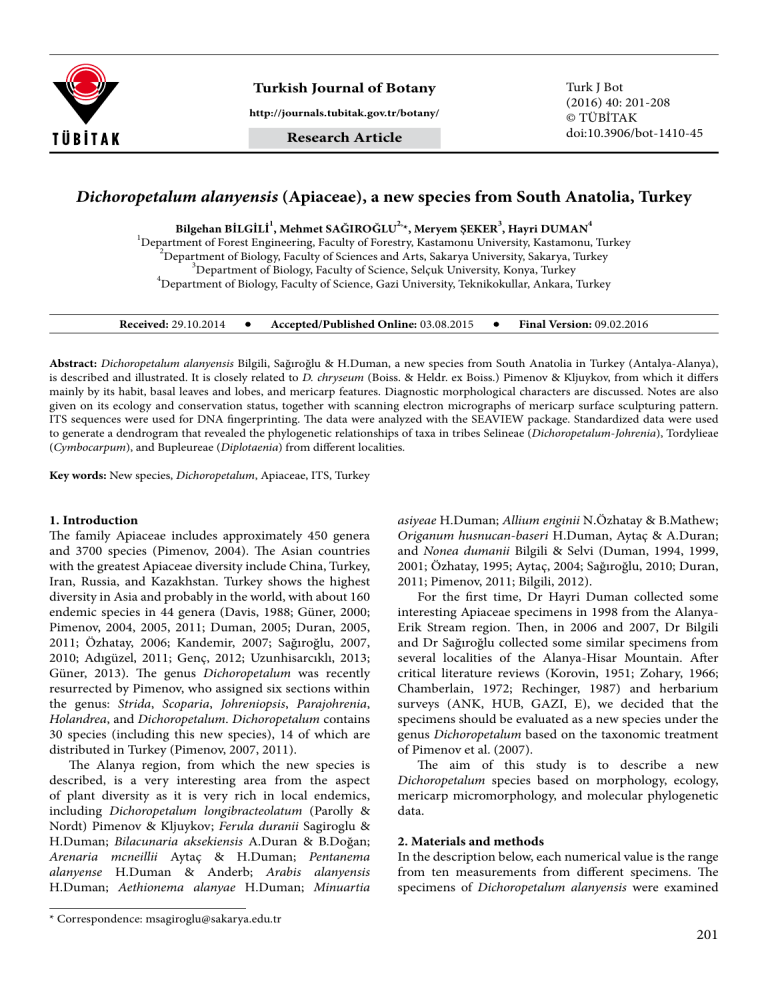
Turkish Journal of Botany
Turk J Bot
(2016) 40: 201-208
© TÜBİTAK
doi:10.3906/bot-1410-45
http://journals.tubitak.gov.tr/botany/
Research Article
Dichoropetalum alanyensis (Apiaceae), a new species from South Anatolia, Turkey
1
1
2,
3
4
Bilgehan BİLGİLİ , Mehmet SAĞIROĞLU *, Meryem ŞEKER , Hayri DUMAN
Department of Forest Engineering, Faculty of Forestry, Kastamonu University, Kastamonu, Turkey
2
Department of Biology, Faculty of Sciences and Arts, Sakarya University, Sakarya, Turkey
3
Department of Biology, Faculty of Science, Selçuk University, Konya, Turkey
4
Department of Biology, Faculty of Science, Gazi University, Teknikokullar, Ankara, Turkey
Received: 29.10.2014
Accepted/Published Online: 03.08.2015
Final Version: 09.02.2016
Abstract: Dichoropetalum alanyensis Bilgili, Sağıroğlu & H.Duman, a new species from South Anatolia in Turkey (Antalya-Alanya),
is described and illustrated. It is closely related to D. chryseum (Boiss. & Heldr. ex Boiss.) Pimenov & Kljuykov, from which it differs
mainly by its habit, basal leaves and lobes, and mericarp features. Diagnostic morphological characters are discussed. Notes are also
given on its ecology and conservation status, together with scanning electron micrographs of mericarp surface sculpturing pattern.
ITS sequences were used for DNA fingerprinting. The data were analyzed with the SEAVIEW package. Standardized data were used
to generate a dendrogram that revealed the phylogenetic relationships of taxa in tribes Selineae (Dichoropetalum-Johrenia), Tordylieae
(Cymbocarpum), and Bupleureae (Diplotaenia) from different localities.
Key words: New species, Dichoropetalum, Apiaceae, ITS, Turkey
1. Introduction
The family Apiaceae includes approximately 450 genera
and 3700 species (Pimenov, 2004). The Asian countries
with the greatest Apiaceae diversity include China, Turkey,
Iran, Russia, and Kazakhstan. Turkey shows the highest
diversity in Asia and probably in the world, with about 160
endemic species in 44 genera (Davis, 1988; Güner, 2000;
Pimenov, 2004, 2005, 2011; Duman, 2005; Duran, 2005,
2011; Özhatay, 2006; Kandemir, 2007; Sağıroğlu, 2007,
2010; Adıgüzel, 2011; Genç, 2012; Uzunhisarcıklı, 2013;
Güner, 2013). The genus Dichoropetalum was recently
resurrected by Pimenov, who assigned six sections within
the genus: Strida, Scoparia, Johreniopsis, Parajohrenia,
Holandrea, and Dichoropetalum. Dichoropetalum contains
30 species (including this new species), 14 of which are
distributed in Turkey (Pimenov, 2007, 2011).
The Alanya region, from which the new species is
described, is a very interesting area from the aspect
of plant diversity as it is very rich in local endemics,
including Dichoropetalum longibracteolatum (Parolly &
Nordt) Pimenov & Kljuykov; Ferula duranii Sagiroglu &
H.Duman; Bilacunaria aksekiensis A.Duran & B.Doğan;
Arenaria mcneillii Aytaç & H.Duman; Pentanema
alanyense H.Duman & Anderb; Arabis alanyensis
H.Duman; Aethionema alanyae H.Duman; Minuartia
*Correspondence: msagiroglu@sakarya.edu.tr
asiyeae H.Duman; Allium enginii N.Özhatay & B.Mathew;
Origanum husnucan-baseri H.Duman, Aytaç & A.Duran;
and Nonea dumanii Bilgili & Selvi (Duman, 1994, 1999,
2001; Özhatay, 1995; Aytaç, 2004; Sağıroğlu, 2010; Duran,
2011; Pimenov, 2011; Bilgili, 2012).
For the first time, Dr Hayri Duman collected some
interesting Apiaceae specimens in 1998 from the AlanyaErik Stream region. Then, in 2006 and 2007, Dr Bilgili
and Dr Sağıroğlu collected some similar specimens from
several localities of the Alanya-Hisar Mountain. After
critical literature reviews (Korovin, 1951; Zohary, 1966;
Chamberlain, 1972; Rechinger, 1987) and herbarium
surveys (ANK, HUB, GAZI, E), we decided that the
specimens should be evaluated as a new species under the
genus Dichoropetalum based on the taxonomic treatment
of Pimenov et al. (2007).
The aim of this study is to describe a new
Dichoropetalum species based on morphology, ecology,
mericarp micromorphology, and molecular phylogenetic
data.
2. Materials and methods
In the description below, each numerical value is the range
from ten measurements from different specimens. The
specimens of Dichoropetalum alanyensis were examined
201
BİLGİLİ et al. / Turk J Bot
and compared taxonomically with specimens of D.
chryseum (Boiss. & Heldr.) Pimenov & Kljuykov and D.
seseloides (C.A.Mey.) Pimenov & Kljuykov.
Representative specimens in the tribe Selinae
(Dichoropetalum chryseum, D. depauperatum (Boiss.
& Balansa ex Boiss.) Pimenov & Kljuykov. comb. nov.,
D. alpinum Fenzl, and Johrenia tortuosa (Fisch. & Mey.)
Chamb.), tribe Tordylieae (Cymbocarpum wiedemannii
Boiss.), and tribe Bupleurae (Diplotaenia turcica Pimenov
& Kljuykov) were used in molecular analyses and were
collected from different localities. Please see the Appendix
for details about specimens.
2.1. DNA isolation
Total DNA was obtained from 50–75 mg of dried leaf
tissue from seven different individuals as listed in Table 1.
An extraction followed the procedure of Doyle and Doyle
(1987) (2X CTAB method), but some modifications were
applied. DNA samples were isolated for every genotype
and concentrations were determined by NanoDrop. DNA
samples were diluted to 25 ng/µL. Stock DNAs were kept
at –80 °C.
2.2. Sequencing reactions
The ITS1-5.8S-ITS2 rDNA region was amplified using
the following primer pair (White et al., 1990): ITS4
(50-TCCTCCGCTTATTGATATGC-30),
ITS-5
(50-GGAAGTAAAAGTCGTAACAAGG-30).
PCRs
were performed in 25-µL reactions containing 12.9 µL
of ddH2O, 2.5 µL of 10X reaction buffer, 2.5 µL of 25
mM MgCl2, 2.5 µL of 5 mM dNTPs, 1.25 µL of each 10
µM primer, 0.1 µL of Ampl. Taq (5 U µL–1), and 1 µL of
dimethyl sulfoxide (DMSO). PCR amplification began
with initial denaturation (94 °C, 2 min), followed by 35
cycles of denaturation (94 °C, 1 min), annealing (60 °C, 1
min), and extension (72 °C, 2 min) with a final extension
(72 °C, 5 min) in a thermocycler (Eppendorf, Applied
Biosystems). The resulting PCR products were checked on
a 1% agarose gel.
PCR amplification and sequencing procedures were
performed for the nuclear regions used in this research.
Purified PCR products (QIAquick Spin PCR Purification
Kit, QIAGEN) were sequenced following the manufacturer’s
instructions. Sequencing was performed with either
BigDye Terminator RR Mix (Applied Biosystems) and
visualized on a CEQ 2000XL DNA Sequencer (Beckman
Coulter), or with an ABI PRISM BigDye Terminator
Premix Cycle Sequencing Kit and visualized on an ABI
PRISM 377 Automated Sequencer (Applied Biosystems).
2.3. Alignment and phylogenetic analyses
Sequences for the above-mentioned taxa were edited using
SEAVIEW (Galtier et al., 1996; Gouy et al., 2010) and were
aligned with MUSCLE under default parameters (Edgar,
2004) followed by manual adjustment. The alignment of
the datasets required the introduction of numerous single
and multiple-base indels (insertions/deletions). Positions
of indels were treated as missing data for all datasets.
The ML analyses were performed for the datasets and
parametric bootstrap values for ML were calculated in
the program SEAVIEW based on 1000 replicates with one
search replicate per bootstrap replicate.
3. Results
3.1. Morphology and taxonomy
Dichoropetalum alanyensis Bilgili, Sağıroğlu & H.Duman.
sp. nov. (Figure 1)
Type: Turkey: C3 Antalya: Alanya-Gökbel plateau,
rocky slopes, 1650 m, 06.07.2006, B.Bilgili 2416 &
M.Sağıroğlu (holotype: GAZI, isotype: ANK, HUB).
Diagnosis: Dichoropetalum alanyensis is closely related
to D. chryseum and D. seseloides. It differs from D. seseloides
(Syn.: Peucedanum meyeri) by its dense inflorescence (not
lax), number of central umbel rays 7–10 (not 10–20),
bracteoles 1–3 (not 3–7), mericarps elliptic (not obovate).
It differs from D. chryseum by its ultimate leaf segments
4–7(–10) mm (not 3–4 mm), dense inflorescence (not
Table 1. Taxa included in the nrDNA ITS analyses.
202
Taxon name
Voucher
DNA source (country, location)
Diplotaenia turcica
A.Duran 8650 & M.Öztürk
Turkey, B9 Bitlis
Cymbocarpum wiedemanni
A.Duran 6428 & Hamzaoğlu
Turkey, A7 Gümüşhane
Dichoropetalum alpinum
A.Duran 7711& Bağcı, Dinc
Turkey, C5 Mersin
Dichoropetalum depauperatum
A.Duran 7687& Bağcı, Dinc
Turkey, C6 Kahramanmaraş
Dichoropetalum chryseum
A.Duran 3233
Turkey, C3 Antalya
Dichoropetalum alanyensis
B.Bilgili 2416 & M.Sağıroğlu
Turkey, C3 Antalya
Johrenia tortuosa
A.Duran 7292
Turkey, B2 Bursa
BİLGİLİ et al. / Turk J Bot
Figure 1. Dichoropetalum alanyensis. A: Flower, B: umbel, C: base of plant and basal leaves, D: fruits (1- dorsal surface, 2- commissural
surface), E: stem and inflorescence, F: basal leaves, G: transverse section of mericarp. (dr = secretory duct in distal part of rib, dc =
commissural secretory ducts (vittae), df = secretory ducts in furrows (vittae), es = endosperm, ex = exocarp, p = parenchyma cells
without pits, pp = parenchyma cells with lignified pitted walls, vb = vascular bundles; B.Bilgili 3324 (GAZI) & M.Sağıroğlu).
203
BİLGİLİ et al. / Turk J Bot
lax), central umbel rays 7–10 (not 12–15), mericarps 3–5
× 1.5–3 mm (not 6–8 × 3–4 mm), and stylopodium conical
(not depressed).
Description: Perennial, polycarpic, glaucescent,
completely glabrous. Rootstock thin, with weakly fibrous
collar, up to 1 cm in diameter. Stem 30–70 cm, intensively
branching, terete, sulcate, glaucous, glabrous, 2–5 mm in
diameter at base. Basal leaves numerous, linear in outline,
6–20 × 1–3 cm; petioles 2–6 cm; lamina bipinnatisect,
glabrous; ultimate segments linear-lanceolate, 4–7(–10)
× 1–2 mm, terminal segments deeply divided (2–3 pairs),
acute. Lower cauline leaves reduced with few segments,
±amplexicaul. Middle and upper cauline leaves very
reduced, semiamplexicaule, sheath-like, linear-lanceolate,
1–5 × 0.2–0.5 cm, membranous, glaucescent, lamina
absent. Inflorescence dense paniculate-corymbose. Umbels
up to 5 cm in diameter. Rays 7–10(–12), 1.5–3 cm long.
Bract usually absent, rarely 1–2. Bracteoles 1–3, linearlanceolate, 1–1.5 mm long. Umbellules with 7–10(–12)
flowers. All flowers hermaphroditic; sepal inconspicuous;
petal yellow, 1–1.5 mm deflexed. Fruiting pedicel 1–2 mm
long, ±equal. Mericarps elliptic, 3–5 × 1.5–3 mm, glaucous
when ripe; dorsal ridges conspicuously filiform, lateral
wings 0.2–0.5 mm wide; stylopodium short conical, 1 mm
long; styles c. 1 mm long reflexed; stigma capitate; dorsal
vittae per vallecula 1, commissural 2. Fl. 6–7, Fr. 7–8.
Paratypes: Turkey: C3 Antalya: Alanya-Yaylacık
mountain, 1600–1700 m, rocky slopes, 09.06.2006, B.Bilgili
2159 (GAZI) & M.Sağıroğlu; ibid., B.Bilgili 3324 (GAZI) &
M.Sağıroğlu; Alanya-Hadim road, around Erikli Deresi,
1300–1350 m, rocky slopes, 24.07.2009, H.Duman 10085
(GAZI).
3.2. Distribution and ecology
Dichoropetalum alanyensis is endemic to South Anatolia
(Antalya-Alanya region) and thus belongs to the East
Mediterranean floristic element. The specimens were
collected from Alanya (Antalya Province), where the
species appears to be restricted and local (Figure 2). D.
alanyensis grows on calcareous stony slopes in open areas
of Pinus nigra Aiton forest in company with Scrophularia
myriopylla Boiss. & Heldr., Rosularia libanotica (Lab.)
Murhead., Alyssum pateri Nyar subsp. pateri, Inula
montbretiana DC., Campanula stellaris Boiss., Dianthus
anatolicus Boiss., Silene anatolica Melzheimer & A.Baytop,
Verbascum myrianthum Boiss., Sideritis erythrantha Boiss.
& Heldr. var. cedretorum Davis, and Onosma frutescens
Lam.
3.3. Conservation status
Dichoropetalum alanyensis is an endemic species known
only from two localities. According to our observations
and field studies, we determined that the area of occupancy
of the new species is less than 2 km2, the population size of
it was estimated to be fewer than 200 mature individuals,
and the population size could be reduced in the near future
based on local grazing pressure. Therefore, we concluded
that the conservation status of the new species should be
evaluated as ‘Critically Endangered (CR)’ in accordance
with IUCN criteria (2011).
4. Discussion
According to recent taxonomic study and multivariate
analysis of the genus Peucedanum s. amplo (Pimenov et al.,
2007), the genus Dichoropetalum is resurrected and some
species from the genus Peucedanum were transferred to
the genus Dichoropetalum because of their inconspicuous
sepals, smaller ultimate segments (shorter than <1 cm),
sessile or petiolulate primary segments, and dentate
or lobate leaf lamina. Our careful morphologic studies
showed that our new species must be placed in the genus
Dichoropetalum rather than the genus Peucedanum.
Figure 2. Distribution of Dichoropetalum alanyensis (▲), D. seseloides (□), and D.
chryseum (●).
204
BİLGİLİ et al. / Turk J Bot
In accordance with literature and herbarium surveys
and molecular data, we concluded that Dichoropetalum
alanyensis is close to D. chryseum and D. seseloides.
However, D. alanyensis clearly differs from them. In Table
2, diagnostic morphological differences among the species
are given.
The distribution patterns of Dichoropetalum alanyensis,
D. seseloides, and D. chryseum are given in Figure 2. As it
is given, D. alanyensis is restricted in the Alanya region in
South Anatolia. However, D. seseloides (Syn.: Peucedanum
meyeri) is distributed in Northeast Anatolia, East Anatolia,
Caucasia, North Iran, and Khorasan (Chamberlain,
1972). D. chryseum is an endemic species and distributed
in West, South, and adjacent parts of Central Anatolia
(Chamberlain, 1972) (Figure 2).
According to the SEM micrographs, the mericarp
surface sculpturing pattern of Dichoropetalum alanyensis is
regular reticulate with distinctly tetrangular or pentangular
cells, whereas D. chryseum is irregularly reticulate-striate
and colliculate to corrugate with inconspicuous and
complicated cells (Figure 3).
The maximum likelihood tree derived from analyses
of the combined nrDNA ITS sequences of Dichoropetalum
alanyensis and related taxa with bootstrap value (Figure 4).
Table 2. Comparison of the diagnostic characters of Dichoropetalum alanyensis, D. chryseum, and D. seseloides.
Characters
D. alanyensis
D. chryseum
D. seseloides
Stem
Glabrous, sulcate
Puberulent at base, ribbed
Glabrous, round
Basal leaves
1–2 pinnate
2 pinnate
1–2 pinnate
Leaves lobes
Linear-lanceolate, glabrous
Linear, scabrid, scabrous
Linear, glabrous
Ultimate segment of leaves
4–7(–10) × 1–2 mm
3–4 × 1–2 mm
8–35 × 1–4 mm
Inflorescence
Dense
Lax
Lax
Rays
7–10(–12)
(12–)15–22
3–9
Fruiting pedicel
1–2 mm
5–8 mm
1–4(–6) mm
Bracteoles
1–3
6–7
3–7
Bract
Usually absent, rarely 1–3
Absent
Absent
Mericarp
Elliptic, 3–5 × 1.5–3 mm
Elliptic, 6–8 × 3–4 mm
Obovate-oblong, 5–7 × 9 mm
Figure 3. Fruit and fruit surface of Dichoropetalum alanyensis and D. chryseum. A: General view fruit of D. alanyensis, B–C:
surface ornamentation of D. alanyensis. D: general view fruit of D. chryseum, E–F: surface ornamentation of D. chryseum.
205
BİLGİLİ et al. / Turk J Bot
Figure 4. Phylogenic tree derived from maximum likelihood
analyses of ITS data.
The length and composition of the ITS4/ITS5 gene region
sequenced were used for analyses. Nucleotide sequences
will be deposited in GenBank. The nuclear ITS4 and ITS5
sequences in Dichoropetalum varied with an average of
631 bp. After alignment, the final dataset consisted of 686
positions. The dataset was analyzed by ML method (PhyMl
ln(L) = –1519.5 sites, HKY85 model in 1000 replicates) and
the bootstrap value was calculated in SEAVIEW (Galtier et
al., 1996; Gouy et al., 2010). According to the results, we
infer 3 clades that contain the tribes Selineae, Tordylieae,
and Bupleureae. Tribe Selineae includes Johrenia tortuosa,
Dichoropetalum alpinum, D. chryseum, D. alpinum, D.
depauperatum, and D. alanyensis; tribe Tordylieae includes
Cymbocarpum wiedemannii; and tribe Bupleureae contains
the Turkish local endemic Diplotaenia turcica (Figure 4).
206
The length and composition of the ITS4/ITS5 gene
region sequenced were used for second analyses. Variation
of the nrITS marker among Dichoropetalum alpinum, D.
chryseum, and D. depauperatum had similar characters and
differs from D. alanyensis in 214 characters. ITS sequence
variation is very high in these species. These characters are
given in Table 3.
Acknowledgments
The authors thank Gazi University (Project no: 05/200550) and Sakarya University (Project no: 2010-02-20-010)
for financial support. We thank Funda Özbek, Ergin
Hamzaoğlu, Ahmet Duran, Yavuz Bağcı, and Muhittin
Dinç for their contributions of molecular samples and
SEM micrographs for this study
BİLGİLİ et al. / Turk J Bot
Table 3. Summary of differences between the nrITS sequences of Dichoropetalum species.
Site position in alignment
1, 2, 3, 6, 11 4, 7
5
8, 9, 10,
12, 13
14, 19
15, 20,
21, 22
16
17, 18
23, 40,
42
24, 30,
41
25, 27
1- D. chryseum
G
T
A
C
T
G
A
C
G
T
C
2- D. depauperatum
…
…
…
…
…
…
…
…
…
…
…
3- D. alpinum
…
…
…
…
…
…
…
…
G
T
C
4- D. alanyensis
…
…
…
…
T
G
A
C
G
T
C
Site position in alignment
29
31
32
33
34
35
36
37
38
39
45
1- D. chryseum
G
C
C
T
A
A
G
…
…
T
G
2- D. depauperatum
G
C
T
C
G
A
C
…
…
T
G
3- D. alpinum
…
A
C
C
G
A
A
…
…
C
G
4- D. alanyensis
G
C
C
C
G
G
A
G
A
T
…
Site position in alignment
48
49
50
51
52
92
207
208, 214
26, 28, 43
46
1- D. chryseum
G
T
T
A
G
…
…
…
A
T
2- D. depauperatum
A
A
G
A
A
C
…
…
…
C
3- D. alpinum
G
T
G
G
A
T
G
A
A
T
4- D. alanyensis
G
T
G
A
A
T
…
…
A
T
Site position in alignment
53, 54, 59, 61, 65, 66, 68,
70, 71, 72, 84, 88, 89
55, 56, 63, 64, 76, 79,
80, 81, 82
57, 60, 67, 69, 73, 77, 83,
86, 87, 91, 93, 94, 101
62, 74, 75,
78, 85, 90
47, 191,
206, 209
1- D. chryseum
…
…
…
…
…
2- D. depauperatum
C
T
G
A
…
3- D. alpinum
C
T
G
A
C
4- D. alanyensis
C
T
G
A
…
159, 160, 171, 179, 184, 188, 192, 199, 145, 146, 147,
201, 202, 174, 178, 180, 181, 182, 190, 198, 142,
204, 205, 186, 187, 189, 193, 195, 196,
148, 149, 152, 154, 158, 116, 117, 125, 127, 131, 138,
143, 150, 153, 157, 166, 172, 121, 126, 129, 133,
197, 165, 167, 168, 169, 175, 176, 183
139, 144, 95, 96, 98, 99, 100, 109, 110, 112, 113
134, 135, 136, 102, 103, 105, 107, 108, 119, 120
106, 114, 123, 124, 155, 156, 164
1- D. chryseum
…
…
…
2- D. depauperatum
C
G
T
3- D. alpinum
…
…
…
4- D. alanyensis
…
…
…
Site position in
alignment
Site position in alignment
151, 161, 162, 163, 170, 173, 177, 185, 194, 200, 203 44, 97, 104, 111, 115, 118, 122, 128, 130, 132, 137, 140, 141
1- D. chryseum
…
2- D. depauperatum
A
3- D. alpinum
…
4- D. alanyensis
…
207
BİLGİLİ et al. / Turk J Bot
References
Adıgüzel N, Bani B, Mavi Ö (2011). Rediscovery of Dichoropetalum
aureum (Umbelliferae) in South Anatolia (Turkey). Phyton 50:
221–230.
Aytaç Z, Duman H (2004). Six new taxa (Caryophyllaceae) from
Turkey. Ann Bot Fenn 41: 213–221.
Bilgili B, Coppi A, Selvi F (2012). Nonea dumanii sp. nov.
(Boraginaceae) from the Taurus mountains (South Turkey).
Nord J Bot 30: 546–542.
Chamberlain DF (1972). Peucedanum L. In: Davis PH, editor. Flora
of Turkey and the East Aegean Islands, Vol. 4. Edinburgh, UK:
Edinburgh University Press, pp. 473–481.
Davis PH, Mill RR, Tan K, editors (1988). Flora of Turkey and the
East Aegean Islands (Suppl. 1.), Vol. 10. Edinburgh, UK:
Edinburgh University Press.
Doyle JJ, Doyle JJ (1987). A rapid DNA isolation procedure for small
quantities of fresh leaf tissue. Phytochem Bull 19: 11–15.
Kandemir A, Hedge I (2007). An anomalous new Ferulago (Apiaceae)
from eastern Turkey. Wildenowia 37: 273–276.
Korovin EP (1951). Johrenia, Peucedanum. In: Shishkin BK, editor.
Flora of USSR, Vol. XVII. Moscow, USSR: Akademi Nauk
SSSR, pp. 36–145 (in Russian).
Özhatay N, Kültür Ş (2006). Check-list of additional taxa to the
supplement Flora of Turkey. III. Turk J Bot 30: 281–316.
Özhatay H, Mathew B (1995). new taxa and notes on the genus Allium
(Alliaceae) in Turkey and Arabia. Kew Bulletin 50: 723–731.
Pimenov MG, Akalın E, Kljuykov E (2005). Prangos ilanae
(Umbelliferae), a new species from western Turkey. Candollea
60: 379–386.
Pimenov MG, Kljuykov EV (2011). Two new species and a new
combination in Turkish Dichoropetalum (Apiaceae). Ann Bot
Fenn 48: 337–342.
Duman H (1994). A new species from South Anatolia Aethionema
alanyae (Brassicaceae). Karaca Arboretum Magazine 2: 171–
176.
Pimenov MG, Kljuykov EV, Ostroumova TA (2007). Critical
taxonomic analysis of Dichoropetalum, Johrenia, Zeravschania
and related genera of Umbelliferae-Apioideae-Peucedaneae.
Willdenowia 37: 465–502.
Duman H (2001). A new species of Arabis L. (Brassicaceae) from
South Anatolia. Bot J Linn Soc 137: 87–90.
Pimenov MG, Leonov MV (1993). The Genera of the Umbelliferae. A
Nomenclature. Kew, UK: Royal Botanic Gardens.
Duman H, Anderberg AA (1999). An undescribed species of
Pentanema Cass. Asteraceae-Inuleae) from Turkey, with notes
on the phylogenetic status of the genus. Bot J Linn Soc 129:
333–338.
Pimenov MG, Leonov MV (2004). The Asian Umbelliferae
biodiversity database (ASIUM) with particular reference to
South-west Asian taxa. Turk J Bot 28: 139–145.
Duman H, Sağıroğlu M (2005). A new species of Ferula (Apiaceae)
from South Anatolia, Turkey. Bot J Linn Soc 147: 357–361.
Rechinger KH (1987). Johreniopsis, Johrenia, Peucedanum. In:
Rechinger KH, editor. Flora Iranica, Vol. 162. Graz, Austria:
Akademische Druck-u. Verlagsanstalt, pp. 374–456.
Duran A, Doğan B, Ay H (2011). Bilacunaria aksekiensis (Apiaceae),
a new species from South Anatolia, Turkey. Ann Bot Fenn 48:
361–367.
Sağıroğlu M, Duman H (2007). Ferula mervynii (Apiaceae), a distinct
new species from North-East Anatolia, Turkey. Bot J Linn Soc
153: 357–362.
Duran A, Sağıroğlu M, Duman H (2005). Prangos turcica (Apiaceae),
a new species from South Anatolia. Turkey. Ann Bot Fenn 42:
67–72.
Sağıroğlu M, Duman H (2010). Ferula brevipedicellata and F. duranii
(Apiaceae), two new species from Anatolia, Turkey. Ann Bot
Fenn 47: 293–300.
Edgar RC (2004). MUSCLE: Multiple sequence alignment with high
accuracy and high throughput. Nucleic Acids Res 32: 1792–
1797.
Sang T, Crawford DJ, Stuessy T (1995). Documentation of reticulate
evolution in peonies (Paeonia) using internal transcribed
spacer sequences of nuclear ribosomal DNA: implication for
biogeography and concerted evolution. P Natl Acad Sci USA
92: 6813–6817.
Galtier N, Gouy M, Gautier C (1996). SEAVIEW and PHYLO_WIN:
two graphic tools for sequence alignment and molecular
phylogeny. Comput Appl Biosci 12: 543–548.
Genç GE, Uruşak EA, Wörz A (2012). A new species of Eryngium
(Apiaceae) from Turkey: Eryngium babadaghensis. Turk J Bot
36: 1–8.
Gouy M, Guindon S, Gauscel O (2010). SeaView version 4: a
multiplatform graphical user interface for sequence alignment
and phylogenetic tree building. Mol Biol Evol 27: 221–224.
Güner A, Özhatay N, Ekim T, Başer KHC, editors (2000). Flora
of Turkey and the East Aegean Islands (Suppl. 2), Vol. 11.
Edinburgh, UK: Edinburgh University Press.
Güner ED, Duman H (2013). The revision of genus Seseli (Umbelliferae)
in Turkey. Turk J Bot 37: 1018–1037.
IUCN (2011). IUCN Standards and Petitions Subcommittee.
Guidelines for Using the IUCN Red List Categories and
Criteria. Version 9.0. Gland, Switzerland: IUCN.
208
Uzunhisarcıklı ME, Duman H, Yılmaz S (2013). A new species
of Bellevalia (Hyacinthaceae) from Turkey. Turk J Bot 37:
651–655.
White TJ, Bruns T, Lee S, Taylor J (1990). Amplification and direct
sequencing of fungal ribosomal RNA genes for phylogenetics.
In: Innis M, Gelfand D, Sninsky J, White T, editors. PCR
Protocols: A Guide to Methods and Applications. San Diego,
CA, USA: Academic Press, pp. 315–322.
Zohary M (1966). Peucedanum. In: Zohary M, editor. Flora
Palaestina, Vol. 2. Jerusalem, Israel: Israel Academy of Sciences
and Humanities, pp. 440–441.
BİLGİLİ et al. / Turk J Bot
Appendix.
- Dichoropetalum chryseum (Syn.: Peucedanum
chryseum): Turkey. C4 Konya: Ermenek, Kazancı Kasabası
civarı, 650–850 m, 21.06.1984, H.Sümbül 3014 (HUB);
Prov. Antalya: Distr. Marmaris, Poor Hills, Ak Dag, rocky
knolls, 22.07.1960, Khan et al. 161 (ANK); Ankara: Kepekli
Boğazı, 10.07.1972, H.Peşmen 1974 (ANK); Ankara:
Çubuk Dere, Krause 4633 (ANK); Antalya: Gündoğmuş,
Oğuz Bölgesi, Pinus brutia ormanı ve açıklığı, 1400–1500
m, 08.08.1991, R.İlarslan & H.Dural 3142 (ANK); Alanya:
Hacıbelen, ca. 1100 m, 28.08.1947, P.H.Davis 14233
(ANK); C3 Antalya: Akseki, Güzelsu-Sadıklar Köyü arası,
ekilmiş tarla, 1200 m, 20.08.1995, A.Duran 3233 (GAZI);
C4 Antalya: Alanya, Derince çevresi, Pinus nigra açıklığı,
taşlık alanlar, 800 m, 31.08.1993 H.Duman 5469 et al.
(GAZI); C3 Antalya: Akseki, Geyran yaylası mevkii, tarla
açıklıkları, 1250 m, 11.08.1994, H.Duman 2040-b (GAZI).
– Dichoropetalum seseloides (Syn.: Peucedanum meyeri.
Johreniopsis seseloides): Iran. Kordeistan: c. 108 km from
Zanjan on road to Bijar. Hot loam slopes, 1700 m, 30 June
1971, J.Lamond 4326 (E); East of Sanandağ, 6000 ft. alt.
fallow, 22.07.1962, P.Furse 3356 (E); In umbrosis montains
Georgiae caucascae. Jul Aug. R.F.Hohenaker 1832 (E),
type of Ferula seseloides Meyer; Kurdistan: 16 km N. of
Husayinabad, between Sanadağ and Sagezi dry exposed
“hills of upland plateau in heavy stony clay among steppe
vegetation”, 2160 m, 16.071966, 3. L.Archibald 3138 (E).
Turkmenistan. The Kopet Dagh Mts., canyon Pordere,
02.07.1978, M.G.Pimenov, E.V.Klğnglov, L.P.Tomkorich,
T.A.Oitroumova 214 (E).
1

